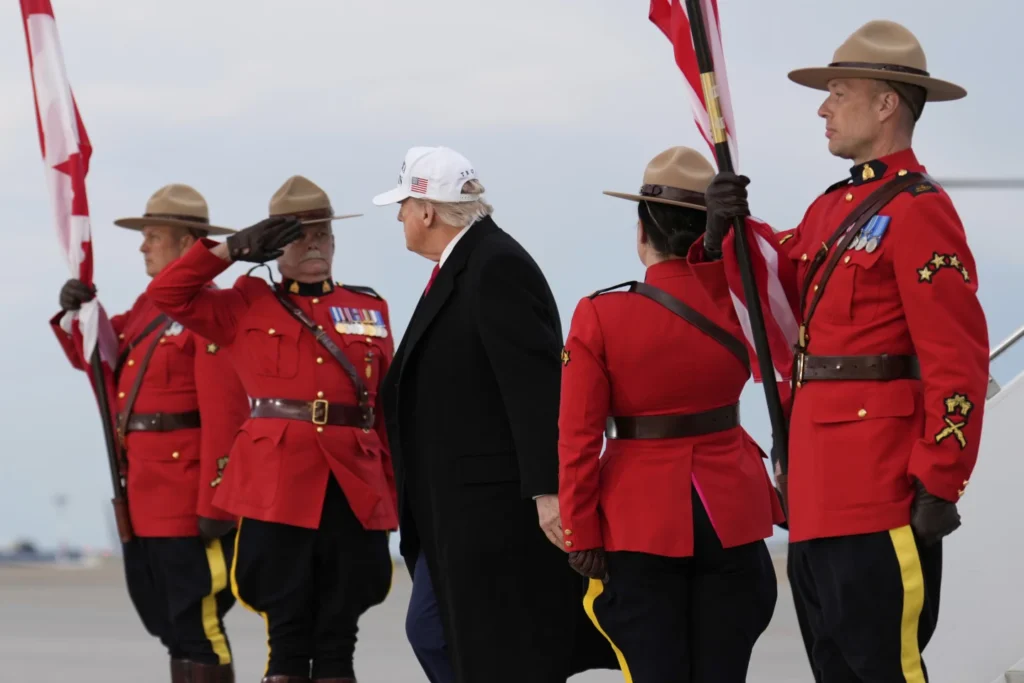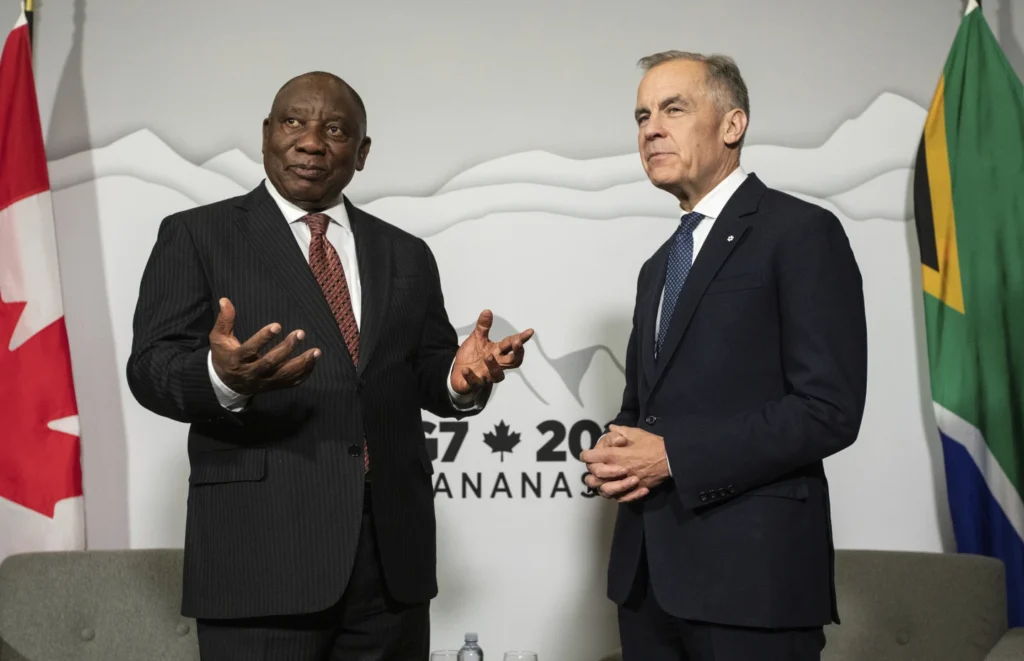BANFF, Alberta — The Group of Seven summit opened Monday in Canada’s Rocky Mountains under a cloud of escalating global conflict, turbulent trade policies, and carefully choreographed diplomacy meant to avoid confrontation with U.S. President Donald Trump.

The meeting comes seven years after Trump’s last appearance at a G7 in Canada, where he famously refused to endorse the summit’s final communiqué, clashed with allies, and unleashed a barrage of insults at Canadian leadership from aboard Air Force One. The image of then-German Chancellor Angela Merkel leaning across a table toward a defiant, arms-crossed Trump became emblematic of the deep divisions that year.
This time, leaders of the world’s top democracies appear united in at least one goal: avoiding a repeat of that political spectacle.
“There’s clearly a shared interest in keeping things calm,” said Peter Boehm, a veteran of six G7 summits and Canada’s counselor at the 2018 meeting in Quebec. “The shadow of Quebec still looms.”
Trump’s arrival in Banff follows a period of intensifying global tension. His administration has issued sweeping new tariffs on dozens of countries, while wars in Ukraine and Gaza continue with no end in sight. Tensions are also rising between Israel and Iran over Tehran’s nuclear activities, further complicating the G7’s traditionally broad agenda that also includes climate change, immigration, AI regulation, and global drug trafficking.
Signaling the Trump administration’s disinterest in collective consensus, no joint communiqué is expected from this year’s summit — a departure from past G7 tradition that underscores Washington’s go-it-alone posture. Instead, Trump’s team appears focused on cementing a unilateral trade framework, intensifying pressure on allies through tariffs and pushing for policies that prioritize American manufacturing and energy expansion.

Caitlin Welsh, a former G7 adviser in Trump’s first term and now a director at the Center for Strategic and International Studies, said the approach reflects a simple philosophy: “The Trump administration almost certainly believes that no deal is better than a bad deal.”
Speaking to reporters before departing the White House on Sunday, Trump hinted at potential new trade announcements, saying, “We have our trade deals. All we have to do is send a letter. ‘This is what you’re going to have to pay.’ But I think we’ll have a few new trade deals.”
His administration has already levied 25% tariffs on steel, aluminum, and automobiles — measures that have hit Japan, Canada, and Mexico particularly hard. Trump has also imposed a 10% baseline tariff on imports from most countries, which could increase after July 9, when a self-imposed 90-day negotiating period ends.
Foreign leaders, well aware of Trump’s volatility, have taken care to emphasize personal rapport. U.K. Prime Minister Keir Starmer said Saturday that he maintains “a good relationship with President Trump,” a sentiment echoed by German, Italian, and Japanese officials. Their hope: keeping Trump engaged without provoking a fresh diplomatic row.
Trump’s bilateral meetings at the summit include sit-downs with Canadian Prime Minister Mark Carney, Mexican President Claudia Sheinbaum, and Ukrainian President Volodymyr Zelenskyy. Each encounter is expected to focus heavily on trade, defense contributions, and efforts to limit China’s economic influence — a particular priority for Washington.
Still, observers warn that Trump’s confrontational tactics may complicate efforts to build a united front.
“Trump will try to coordinate the group against China’s economic coercion,” wrote Josh Lipsky, chair of international economics at the Atlantic Council. “But the rest of the leaders may turn back to Trump and say that this kind of coordination, which is at the heart of why the G7 works, would be easier if he weren’t imposing tariffs on his allies.”
Canada and Mexico, both of which were signatories to the 2020 U.S.-Mexico-Canada Agreement (USMCA), are now facing tariffs of up to 25% — some under the guise of fentanyl interdiction. While certain products remain protected under USMCA provisions, Canadian officials have expressed growing unease about Washington’s long-term reliability.
“Canada can no longer look to the U.S. as an enduring friend,” Prime Minister Carney said last week, reflecting the broader mood of uncertainty among U.S. allies.
Trade has not been the only point of contention. Trump’s rejection of climate goals, insistence on fossil fuel expansion, and skepticism of multilateral institutions have also widened the rift. The absence of a joint G7 statement this year is seen by many as symbolic of a deeper fracture in global cooperation.
Still, the summit retains significance as a rare opportunity for face-to-face diplomacy. Originating in 1973 as a forum for finance ministers to coordinate responses to the oil crisis, the G7 has evolved into an annual gathering of heads of government to address global issues and foster personal ties. It briefly expanded into the G8 when Russia joined in 1997 but reverted back to seven nations after Russia’s 2014 annexation of Crimea.
With the wars in Ukraine and Gaza far from resolved, and a new round of hostilities threatening to erupt between Israel and Iran, the summit’s global security focus is urgent. Trump’s planned meeting with Zelenskyy is expected to touch on military aid and territorial integrity, but also on Trump’s calls for Europe to shoulder more of the burden.
While discussions on artificial intelligence, climate policy, and global economic growth remain on the agenda, few expect major breakthroughs.
“The reality is, this summit is more about optics and survival than substance,” one European diplomat said privately. “It’s about managing Trump — not solving the world’s problems.”
As leaders gather in the tranquil setting of Banff, the stakes remain high. Whether the summit will reinforce the G7’s value or further expose its fractures will likely depend not just on shared policy, but on the temperament of one man — and how the world responds to him.



